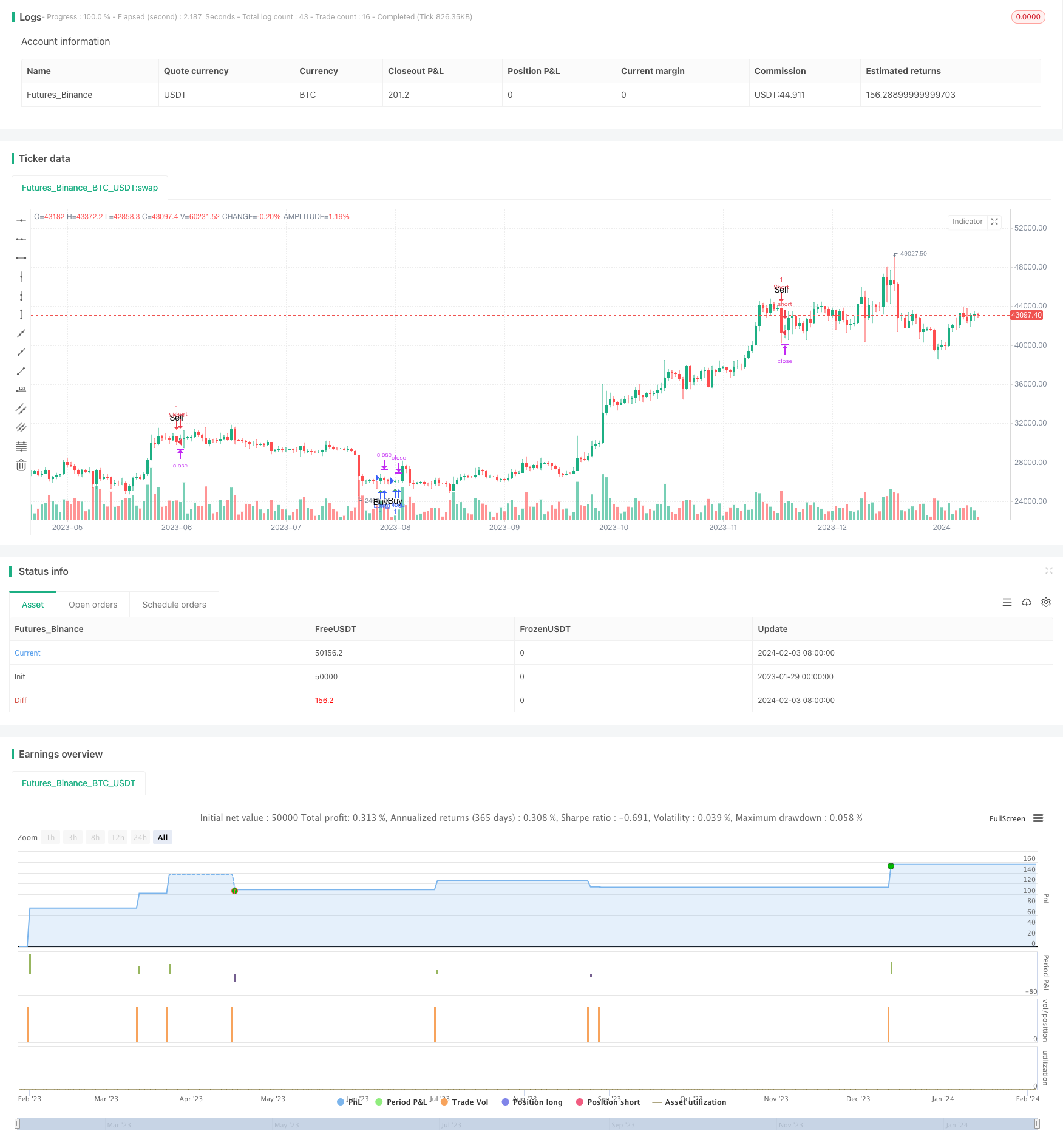
概述
蜡烛包裹RSI交易策略是一种试图利用蜡烛形态分析和相对强弱指数(RSI)指标的组合来产生交易信号的策略。它对RSI指标的两端水平,以及多头和空头的蜡烛包裹形态进行检测,并产生交易信号。
策略原理
该策略的核心思想是结合使用RSI和蜡烛线形态分析。
关于RSI,该策略设置了两端水平,分别是过买水平(默认70)和过卖水平(默认30)。当RSI高于过买水平时产生RSI超买信号,当RSI低于过卖水平时产生RSI超卖信号。这表示价格可能反转。
关于蜡烛形态分析,策略检测是否出现多头或空头的蜡烛包裹形态。多头蜡烛包裹指今日收盘价高于昨日开盘价,且昨日收盘价低于昨日开盘价。空头蜡烛包裹则相反,其中今日收盘价低于昨日开盘价,且昨日收盘价高于昨日开盘价。根据推理,这些蜡烛形态通常标志着价格的反转点。
综合以上,当多头蜡烛包裹发生时,若之前也有RSI超卖信号,则产生买入信号。而当空头蜡烛包裹发生时,若之前也有RSI超买信号,则产生卖出信号。通过这种组合,策略试图在价格反转点捕捉趋势。
优势分析
该策略有以下几个主要优势:
结合使用了RSI指标和蜡烛形态分析,综合利用了两种不同类型的技术分析手段,可以使信号更加可靠。
RSI指标常用于判断价格反转点。结合蜡烛形态验证,可以更准确判断反转的时机。
蜡烛形态包裹常在价格反转点出现。与RSI指标组合使用,可以使交易信号更加及时。
该策略交易机会较多,适合频繁交易。由于仅关注RSI和蜡烛形态,无需其他复杂条件判定,交易机会较多。
可以灵活调整RSI参数,适应不同品种和市场环境,提高策略的适应性。
风险分析
该策略也存在一些风险,主要是:
蜡烛形态分析和RSI指标都可能产生假信号,导致不必要的亏损。
策略可能因RSI和蜡烛形态分析判断错误而错过主要趋势方向。
市场剧烈波动时,止损可能被突破,造成大额亏损。
过于频繁交易可能增加交易成本和滑点成本。
为控制这些风险,可以从以下几个方面进行优化:
适当调整RSI参数,或增加其他指标过滤,减少假信号。
增加趋势判断指标,避免逆势交易。
优化止损策略,在市场突破时及时止损。
适当缩减交易频率,控制成本。
优化方向
该策略还可以从以下几个方面进行进一步优化:
增加移动止损策略,让止损随价格波动而自动调整,减少止损被突破的概率。
增加其他指标或条件来过滤信号,如MACD,布林带等,使信号更加可靠。
在高波动产品中,可以设置ATR止损以自动调整止损幅度。
对交易品种进行统计分析,优化RSI参数的设置,使其更符合该品种的特点。
结合机器学习方法如回归分析,学习哪些RSI和蜡烛形态参数组合对品种交易效果最佳。
增加自适应调整RSI参数和止损幅度的功能模块,使策略参数动态优化。
通过这些优化,可以减少交易风险,提高策略稳定性,并使策略对市场的适应性更强。
总结
总之,该策略利用RSI指标和蜡烛形态判定价格反转点,在反转点捕捉趋势。它综合运用两种类型分析方法形成交易信号。该策略具有交易频率高、灵活适应性强等优势。但也存在一些风险如产生假信号和止损被套等。通过参数优化、风险控制等手段可以降低这些风险。该策略有进一步优化的空间,通过持续优化和改进,可以成为一个稳定可靠的交易策略。
/*backtest
start: 2023-01-29 00:00:00
end: 2024-02-04 00:00:00
period: 1d
basePeriod: 1h
exchanges: [{"eid":"Futures_Binance","currency":"BTC_USDT"}]
*/
//@version=4
strategy("EngulfingCandle Strategy", overlay=true)
// Your existing definitions
bullishCandle=close >= open[1] and close[1] < open[1]
bearishCandle=close <= open[1] and close[1] > open[1]
// RSI Definitions
rsiSource=input(close, title="rsiSource")
rsiLenghth=input(14, title="rsi length", type=input.integer)
rsiOverBought=input(70, title="rsi overbought level", type=input.integer)
rsiOverSold=input(30, title="rsi over sold level", type=input.integer)
rsiValue=rsi(rsiSource, rsiLenghth)
isRSIOB=rsiValue >= rsiOverBought
isRSIOS=rsiValue <= rsiOverSold
// Trade Signal
tradeSignal=((isRSIOS or isRSIOS[1] or isRSIOS[2]) and bullishCandle ) or ((isRSIOB or isRSIOB[1] or isRSIOB[2]) and bearishCandle)
// Stop Loss and Take Profit Inputs
sl_pips = input(20, title="Stop Loss (in pips)")
tp_pips = input(40, title="Take Profit (in pips)")
// Calculating Stop Loss and Take Profit Prices
long_sl = close - syminfo.mintick * sl_pips
long_tp = close + syminfo.mintick * tp_pips
short_sl = close + syminfo.mintick * sl_pips
short_tp = close - syminfo.mintick * tp_pips
// Entering and Exiting Trades
if (tradeSignal and bullishCandle)
strategy.entry("Long", strategy.long)
strategy.exit("Exit Long", "Long", stop=long_sl, limit=long_tp)
if (tradeSignal and bearishCandle)
strategy.entry("Short", strategy.short)
strategy.exit("Exit Short", "Short", stop=short_sl, limit=short_tp)
// Plotting
plotshape(tradeSignal and bullishCandle, title="Bullish", location=location.belowbar, color=color.green, style=shape.triangleup, text="Buy")
plotshape(tradeSignal and bearishCandle, title="Bearish", location=location.abovebar, color=color.red, style=shape.triangledown, text="Sell")